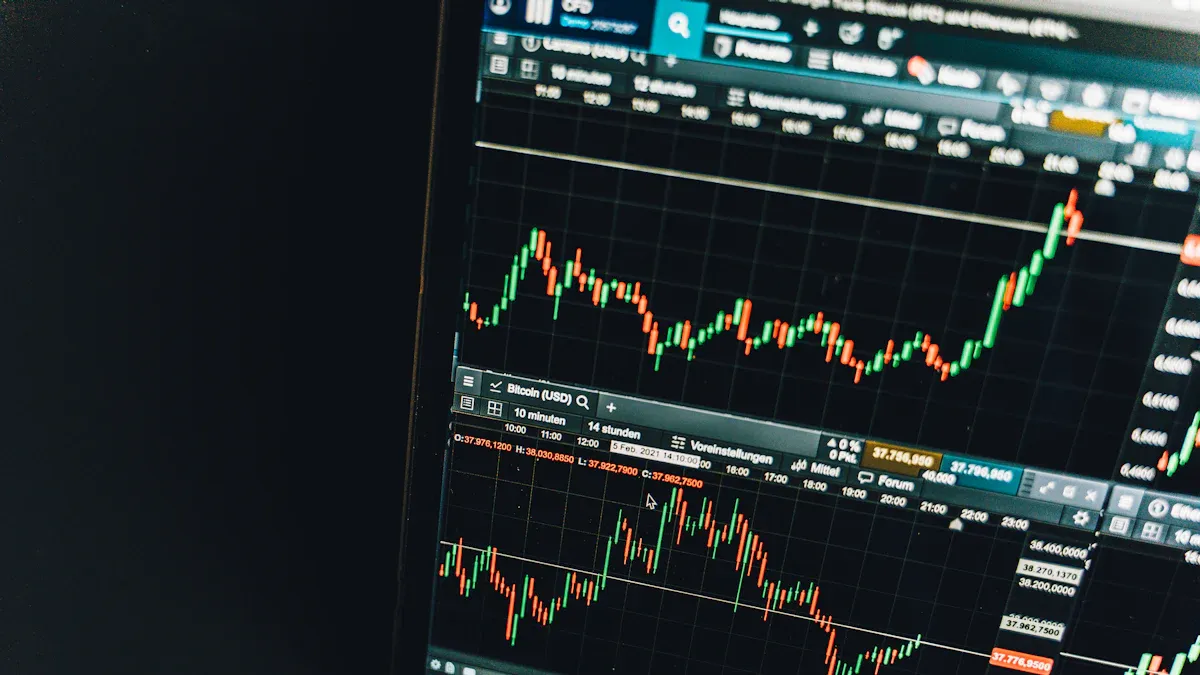- EasyCard
- Trade
- Help
- Announcement
- Academy
- SWIFT Code
- Iban Number
- Referral
- Customer Service
- Blog
- Creator
Efficient stock selection: using turnover rate to capture active stocks in the market

Image Source: pexels
When you aim for efficient stock selection, you should focus on the turnover rate as a core metric. The turnover rate reflects a stock’s market activity and level of investor attention. Data shows that the correlation between market capitalization and turnover rate is 0.5, and the correlation between turnover rate and total trading value is 0.4.
| Metric | Correlation |
|---|---|
| Market Capitalization and Turnover Rate | 0.5 |
| Turnover Rate and Total Trading Value | 0.4 |
Stocks with high turnover rates are often easier to identify as market hotspots. By analyzing the turnover rate, you can enhance your ability to select stocks efficiently.
Key Takeaways
- The turnover rate is an important metric for assessing a stock’s market activity. Focusing on the turnover rate can help you quickly identify trending stocks in the market.
- Setting a turnover rate screening range between 3%-7% typically allows you to find active stocks with high investor attention.
- Combining turnover rate with trading volume and fundamental analysis can improve the accuracy and rigor of stock selection.
- Regularly monitoring changes in turnover rate allows timely adjustments to your investment portfolio to address market volatility and risks.
- Stocks with high turnover rates may incur higher trading costs, so you should carefully assess risks and combine other metrics for comprehensive judgment.
Turnover Rate Basics
Definition
When conducting efficient stock selection, you must first understand the basic concept of turnover rate. Turnover Rate is a key metric in the stock market, reflecting the level of buying and selling activity for a stock over a specific period. It is a critical measure of stock liquidity. Simply put, the turnover rate represents the ratio of traded shares to the total number of shares outstanding within a given period. By observing the turnover rate, you can quickly gauge a stock’s market activity.
- The turnover rate reflects a stock’s liquidity.
- It reveals the level of investor attention and trading intensity in the market.
- You can use the turnover rate to filter out the most active stocks in the market.
Calculation Method
In practice, you can calculate the turnover rate using the following formula:
| Formula | Description |
|---|---|
| Turnover Rate | Trading Volume / Shares Outstanding × 100% |
For example, if a stock has a trading volume of 5 million shares in a week and 100 million shares outstanding, the weekly turnover rate is 5%. You can calculate the turnover rate over different periods (daily, weekly, monthly) and flexibly apply it to efficient stock selection strategies.
Activity Relationship
The turnover rate is closely related to market activity, liquidity, and volatility. You will notice that stocks with high turnover rates typically exhibit active trading and frequent capital inflows and outflows. Research shows that as a proxy for liquidity, the turnover rate has a negative correlation with stock returns, but in emerging markets, stocks with high turnover rates have higher expected returns. The table below summarizes relevant research findings:
| Research Topic | Key Findings |
|---|---|
| Stock Market Turnover Rate and Returns | Investors in high-turnover markets expect higher returns, especially in emerging markets. |
| Turnover Rate and Volatility | Turnover rate and volatility are significant factors affecting index returns, with volatility effects influenced by other factors. |
| Liquidity and Stock Returns | As a proxy for liquidity, turnover rate is negatively correlated with stock returns. |
You should also note that changes in market structure can affect the reliability of turnover rates. For example, in the U.S. market, institutional trading and technological advancements have increased trading activity and reduced trading costs. Stocks with high institutional ownership see more significant increases in turnover rates. These changes may impact market efficiency and volatility. Therefore, when selecting stocks efficiently, you should consider both the turnover rate itself and the broader market structure and trading environment for a comprehensive judgment.
Tip: Common turnover rate ranges include 2%, 3%-7%, and 5% or higher. Generally, a turnover rate below 2% indicates a relatively inactive stock, 3%-7% is an active range, and above 5% suggests high investor attention. You can use these ranges to flexibly filter out market hotspot stocks.
Efficient Stock Selection Strategies

Image Source: pexels
Screening Process
To achieve efficient stock selection, you can follow this process:
- Define your stock selection goals. You need to determine whether you are focusing on short-term trading or medium-to-long-term investment.
- Set a turnover rate screening range. You can prioritize stocks with turnover rates between 3%-7%, as these stocks typically have high investor attention and strong market activity.
- Combine trading volume and price trends. You can observe whether trading volume is consistently increasing and whether the price breaks through key levels.
- Further screen based on fundamentals. You can exclude companies with declining performance or financial irregularities, prioritizing those with strong profitability and growth potential.
- Dynamically track changes in turnover rate. You can regularly review the turnover rates of your portfolio holdings and adjust your investment portfolio as needed.
Tip: You can combine the turnover rate with other metrics to improve the accuracy of efficient stock selection.
Metric Standards
When setting turnover rate standards, you need to consider the specific conditions of different markets. Here are the characteristics of turnover rates in major exchanges:
- The turnover rate in mainland China’s market is generally high, partly due to retail investors’ preference for short-term trading and trend-following behavior.
- The turnover rate standards in the New York Stock Exchange (NYSE) and NASDAQ differ significantly from those in mainland China, typically being more stable.
- In mainland China, some large state-owned enterprises have lower liquidity, but the overall market activity is high.
You can refer to the following common turnover rate ranges:
| Turnover Rate Range | Market Implication |
|---|---|
| Below 2% | Low market attention |
| 3%-7% | Active market range |
| Above 5% | High investor attention |
You can adjust the turnover rate screening criteria flexibly based on your risk tolerance.
Multi-Factor Integration
When selecting stocks efficiently, you cannot rely solely on the turnover rate. You can combine the turnover rate with trading volume, fundamentals, and valuation metrics to enhance the rigor of stock selection. Academic research shows that multi-factor models perform strongly in real-world investments. For example, the PMO factor model, which compares low-turnover and high-turnover stock portfolios, achieved an annual return of 12%. You can refer to the table below:
| Model Name | Key Factors | Annual Return | Applicable Market |
|---|---|---|---|
| PMO Factor | Low-turnover stock portfolio minus high-turnover stock portfolio | 12% | Chinese Market |
You can integrate multi-factor models to select active stocks with greater growth potential.
Case Study
You can understand the practical application of efficient stock selection by analyzing market performance during past bull markets. For example, in the previous bull market in mainland China, top-performing stocks saw record-high turnover rates and trading volumes. The table below shows market data from that period (converted to USD):
| Metric | Value |
|---|---|
| Average Monthly Trading Volume | $309 billion |
| Previous Record-High Trading Volume | $280 billion |
| CSI 300 Index Monthly Gain | Nearly 10% |
| Investor Participation | Increased retail investor participation |
| Recorded Hong Kong Stock Sales | $2.6 billion |
You can see that during periods of heightened market activity, turnover rates and trading volumes rise in tandem, making active stocks more likely to attract investor attention. In practice, you can combine turnover rate, trading volume, and price trends to promptly capture market hotspots and achieve efficient stock selection.
Advantages and Risks

Image Source: pexels
Advantages of Efficient Stock Selection
When using turnover rate for efficient stock selection, you can gain multiple advantages. First, the turnover rate helps you quickly identify active stocks in the market. These stocks typically have strong liquidity, making it easier to capture market hotspots. You can also use the turnover rate to flexibly adjust your investment portfolio, keeping pace with market changes. Research from financial analysts shows that using turnover rate for stock selection can significantly improve cash flow efficiency and profitability. See the table below:
| Advantage | Description |
|---|---|
| Improved Cash Flow Efficiency | Increased by 30% |
| Improved Profitability | Increased by 25% |
| Reduced Operating Costs | Data not provided |
| Improved Customer Satisfaction | Data not provided |
You can see that the turnover rate strategy not only enhances capital efficiency but also delivers stronger returns.
Risk Types
When focusing on high-turnover stocks, you must also be cautious of associated risks. High turnover rates can lead to increased market volatility, with stock prices prone to sharp fluctuations. You may also incur higher trading costs and taxes due to frequent trading. Financial research indicates that relying solely on turnover rate for stock selection can be misleading and requires integration with market context and other factors. Additionally, market anomalies can affect the predictive power of turnover rates. The table below summarizes related impacts:
| Evidence Type | Description |
|---|---|
| Relationship | Monthly returns are positively correlated with average turnover rate |
| Impact | High turnover rates may lead to higher trading costs, reducing strategy profitability |
| Conclusion | Market efficiency and costs associated with high turnover rates may weaken their effectiveness |
- Relying solely on turnover rate for stock selection may lead to misjudgments
- Requires integration with trading context and overall investment strategy
- High turnover rates bring higher trading costs and volatility risks
Risk Mitigation
You can adopt multiple strategies to address the risks associated with high turnover rates. First, adopting a long-term investment strategy and reducing short-term trading can help lower the impact of capital gains taxes. You can also minimize portfolio turnover to avoid increased trading costs from frequent buying and selling. Tax optimization is another key approach, such as using tax-loss harvesting to offset realized capital gains. The table below lists common risk management strategies:
| Risk Management Strategy | Description |
|---|---|
| Adopt Long-Term Investment Strategy | Reduce short-term trading to lower capital gains tax impact |
| Minimize Portfolio Turnover | Reduce trading costs and improve long-term performance |
| Use Tax Optimization Strategies | Tax-loss harvesting helps offset realized capital gains |
In practice, you can combine these methods to enhance the safety and stability of efficient stock selection.
Continuous Optimization
Data Monitoring
To continuously optimize your investment portfolio, you need to regularly monitor turnover rate data. Automated tools can help you efficiently track changes in turnover rates. You can use signal and autocorrelation analysis to promptly identify shifts in market activity. Many quantitative portfolio managers adjust their holdings based on these signals to achieve excess returns. You also need to focus on trading costs, as high turnover rates incur higher fees. Selecting low-turnover signals can help reduce trading costs and improve overall performance. Accurately predicting portfolio turnover under specific signals is critical for portfolio management. You can refer to the following practices:
- Use automated tools to regularly collect and analyze turnover rate data
- Combine signal analysis to dynamically adjust portfolio allocation
- Focus on trading costs and prioritize low-turnover signals
- Predict turnover rates under different signals to optimize investment decisions
Tip: You can leverage publicly available U.S. market data and professional analysis tools to improve the efficiency and accuracy of data monitoring.
Strategy Adjustment
Based on data monitoring, you need to flexibly adjust your stock selection strategy. Trends in turnover rate often signal shifts in market style. You can optimize your strategy with the following methods:
- Understand the position of your investment targets in their lifecycle to assess growth potential and risks
- Improve the accuracy of market demand predictions to identify potential hotspots promptly
- Monitor stocks approaching a decline phase and reduce their portfolio weight as needed
You can combine turnover rate with other factors to dynamically optimize your investment portfolio. U.S. market experience shows that continuous strategy optimization helps improve long-term returns. You need to remain sensitive to market changes and adjust your investment direction promptly to keep your portfolio in an optimal state.
In the process of efficient stock selection, you can use the turnover rate as a key reference metric. Scientifically analyzing the turnover rate can help you make more rational judgments about market activity. Research shows that low-turnover stocks tend to have higher future returns, and the turnover effect remains robust across various market conditions. You can refer to the table below for related research findings:
| Evidence Point | Description |
|---|---|
| 1 | In the Chinese stock market, low-turnover stocks have higher future returns. |
| 2 | The turnover effect remains robust after controlling for various liquidity metrics. |
| 3 | The turnover effect is stronger when investor sentiment is high. |
| 4 | The turnover effect is more pronounced in stocks with low investor sophistication, high idiosyncratic volatility, high trading costs, and low institutional ownership. |
| 5 | The turnover effect persists over longer time horizons. |
You should combine your investment style with continuous optimization of your stock selection strategy. Focus on risk management to enhance the rigor and flexibility of your investment decisions.
FAQ
What does a high turnover rate indicate?
When you see a high turnover rate, you can infer that the stock is actively traded. Capital flows are frequent, and market attention is high. You can use a high turnover rate to identify trending stocks.
Tip: A high turnover rate does not necessarily indicate a high-quality stock. You need to combine it with other metrics for analysis.
Are low-turnover stocks suitable for investment?
When you notice a low turnover rate, it indicates lower stock liquidity. Investor attention is limited. You can choose low-turnover stocks for long-term investments. You should be mindful of liquidity risks.
| Turnover Rate Range | Investment Advice |
|---|---|
| Below 2% | Suitable for long-term holding |
| 3%-7% | Suitable for flexible trading |
What is the difference between turnover rate and trading volume?
When analyzing, you find that the turnover rate reflects stock liquidity. Trading volume represents the total number of shares traded. You can use the turnover rate to gauge market activity. You use trading volume to observe capital inflows and outflows.
- Turnover Rate: Focuses on liquidity
- Trading Volume: Focuses on transaction scale
How can I use turnover rate to select active U.S. stocks?
You can set a turnover rate screening range, such as 3%-7%. You combine trading volume and price trends to identify U.S. stocks with high investor attention. You can also refer to company fundamentals to improve stock selection accuracy.
Suggestion: You can use publicly available U.S. market data and automated tools to screen active stocks.
How do changes in turnover rate affect investment strategies?
When you observe changes in turnover rate, you can adjust your investment portfolio accordingly. A rising turnover rate indicates increasing market activity. You can increase your portfolio allocation. A declining turnover rate suggests lower investor attention. You can reduce exposure to mitigate risks.
By mastering turnover ratio analysis, you’ve learned to identify market-active stocks and capitalize on high-liquidity opportunities, but high cross-border fees, currency volatility, and complex account setups can limit swift responses to U.S. market dynamics, especially during turnover spikes or hotspot shifts. Imagine a platform with 0.5% remittance fees, same-day global transfers, and zero-fee limit orders, enabling seamless turnover-based strategies via one account?
BiyaPay is tailored for active stock traders, offering instant fiat-to-digital conversions to act on market signals nimbly. With real-time exchange rate query, monitor USD trends and transfer at optimal moments to cut costs. Covering most regions with instant arrivals, it powers rapid allocations to S&P 500 ETFs (like SPY) or high-turnover tech stocks. Crucially, trade U.S. and Hong Kong markets through a single account, leveraging zero-fee limit orders for turnover and volume-based selection strategies.
Whether chasing market hotspots or mitigating volatility risks, BiyaPay fuels your edge. Sign up now, visit stocks for U.S. prospects—quick setup unlocks cost-effective, data-driven trading. Join global investors and thrive in 2025’s markets!
*This article is provided for general information purposes and does not constitute legal, tax or other professional advice from BiyaPay or its subsidiaries and its affiliates, and it is not intended as a substitute for obtaining advice from a financial advisor or any other professional.
We make no representations, warranties or warranties, express or implied, as to the accuracy, completeness or timeliness of the contents of this publication.




Contact Us
Company and Team
BiyaPay Products
Customer Services
is a broker-dealer registered with the U.S. Securities and Exchange Commission (SEC) (No.: 802-127417), member of the Financial Industry Regulatory Authority (FINRA) (CRD: 325027), member of the Securities Investor Protection Corporation (SIPC), and regulated by FINRA and SEC.
registered with the US Financial Crimes Enforcement Network (FinCEN), as a Money Services Business (MSB), registration number: 31000218637349, and regulated by FinCEN.
registered as Financial Service Provider (FSP number: FSP1007221) in New Zealand, and is a member of the Financial Dispute Resolution Scheme, a New Zealand independent dispute resolution service provider.



















